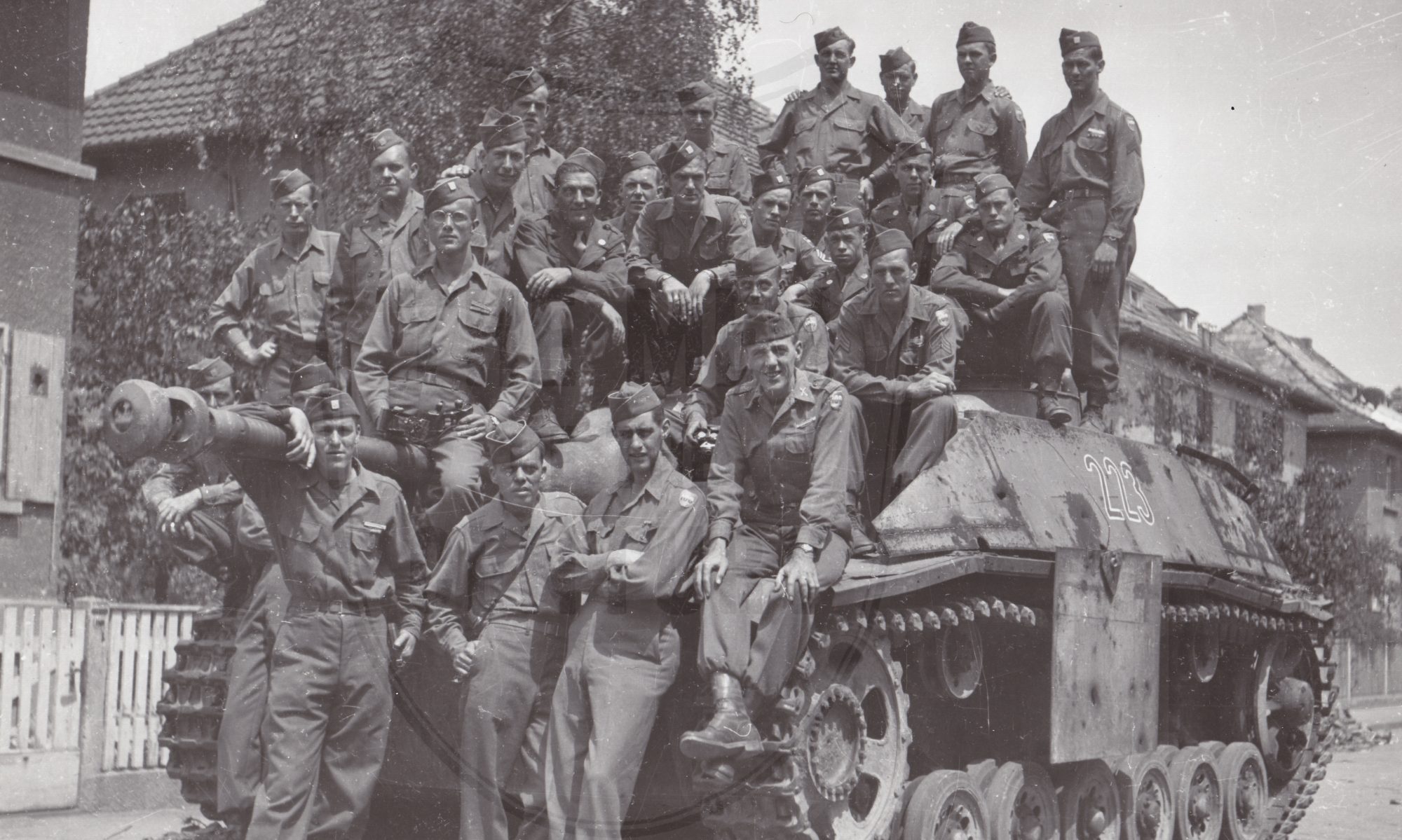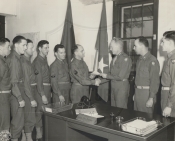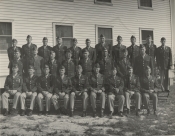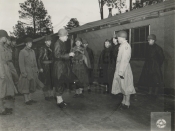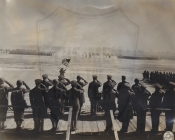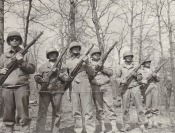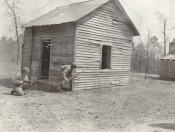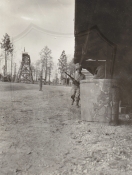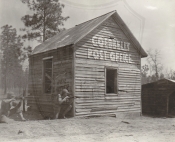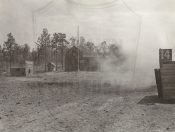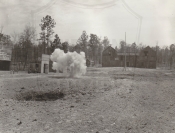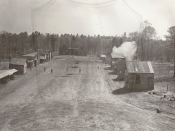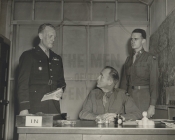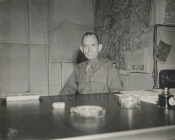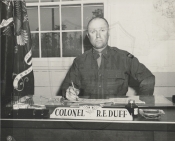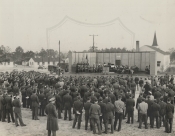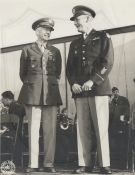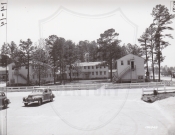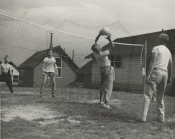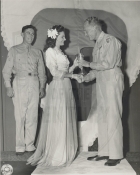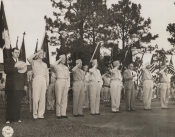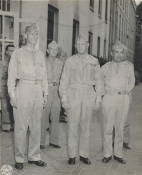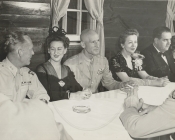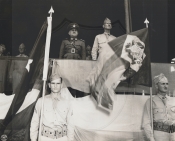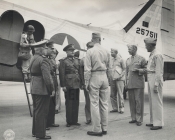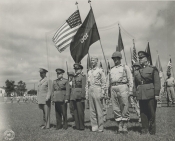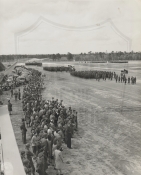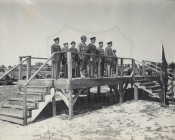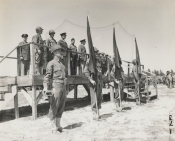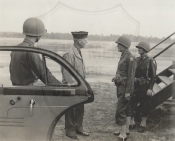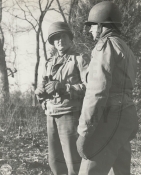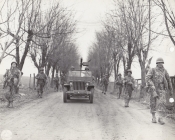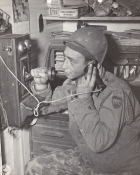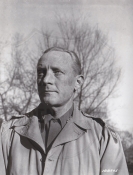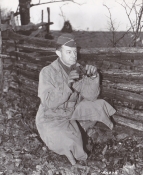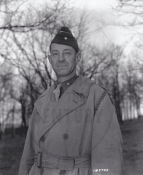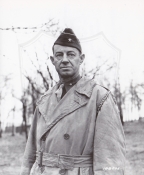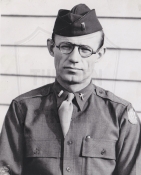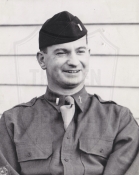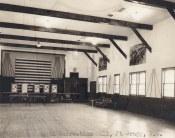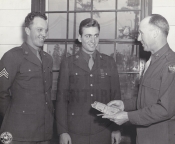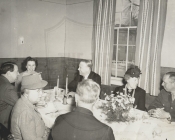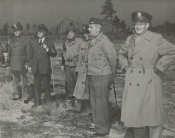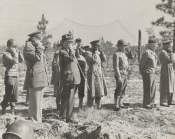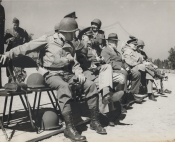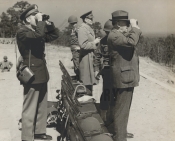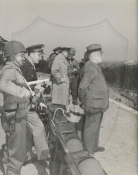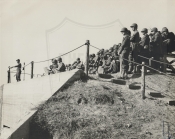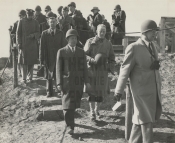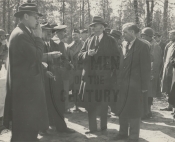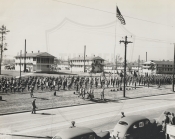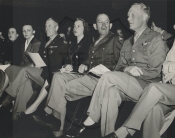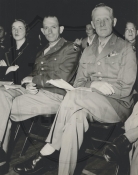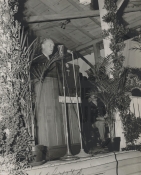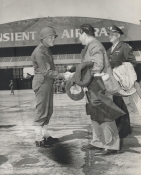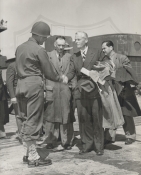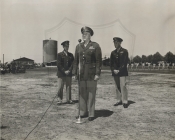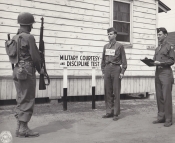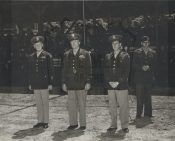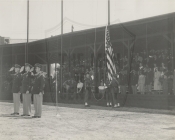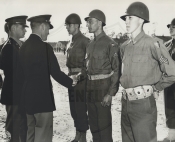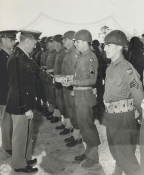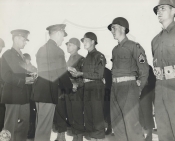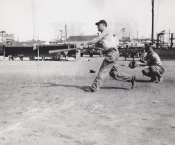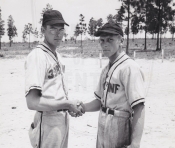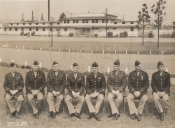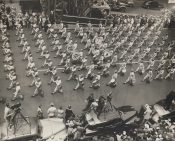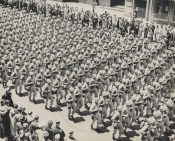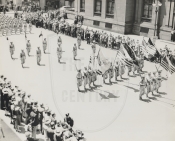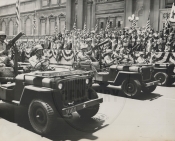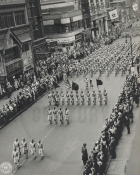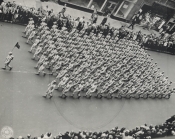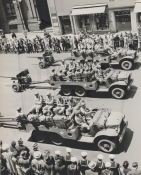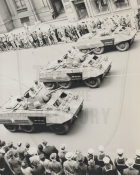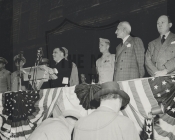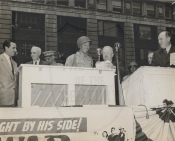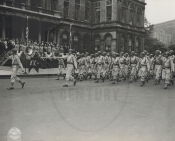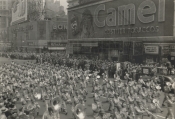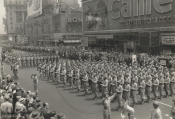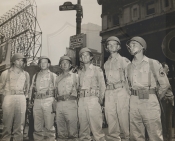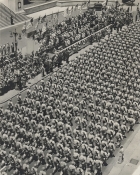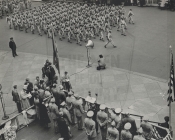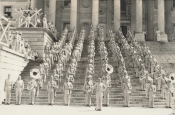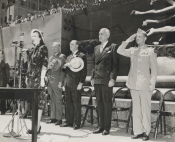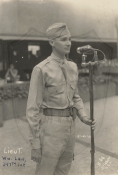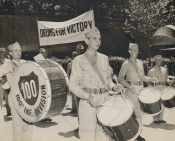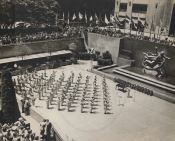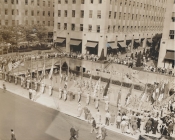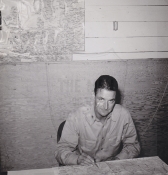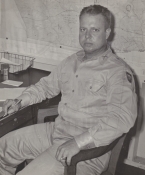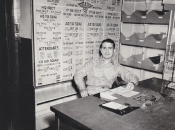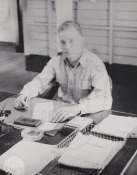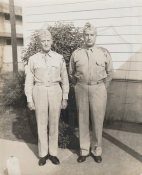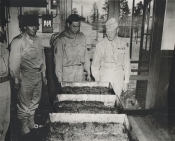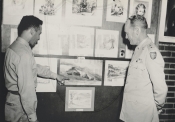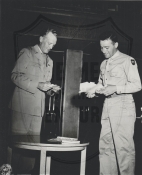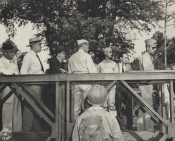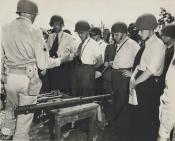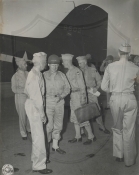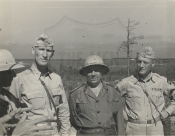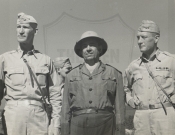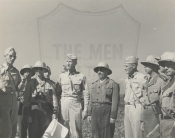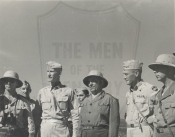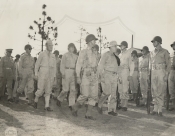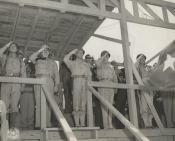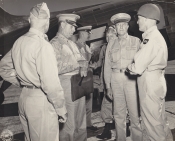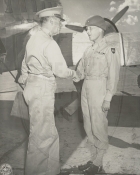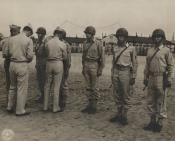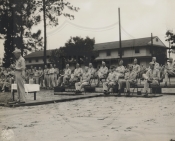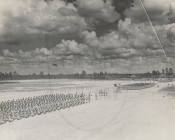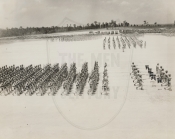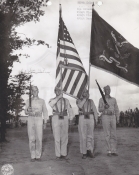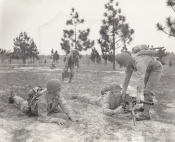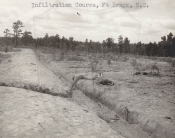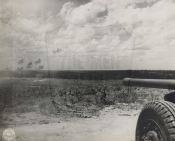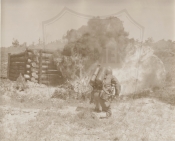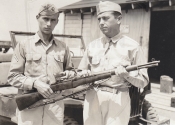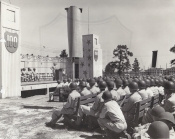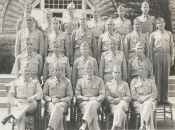
Eighth New Divisions Course, August September, 1942, 100th Infantry Division.
Back Row: Cherry, J.F., Capt., CMP. PM; Reinecke, P. S., Jr., Capt., Inf., Asst G-2; Bollard, A. W., Capt., Inf., Asst G-3; Hefley, R. C., Capt., Inf., Asst G-4; Williams, R. M., Capt., Inf., Hq Co CO; Rawlings, W. V., Capt., FA., Aide
Third Row: Dougherty, C. E., Major, CE.; Engr; Kemble, F., Jr., Major, OD., OO; Olin, C. L., Major, SC., Sig O; Nelson, G. E., Lt. Col., AGD., AG; Betz, W.R., Major, CWS., CWO; Lewis, N.D., Capt., Cav., Rcn Tr CO
Second Row: Mollohan, C. S., Lt. Col., MC., Surg; Stegmaier, R. M., Major, QMC., QM; Gingrich, R. J., Lt. Col., IGD., IG; Forbush, C. H., Major, FA., G-1; Lynch, R. J., Capt., JAGD., JAG
Front Row: Phasey, V. E., Lt. Col., Inf., G-2; McClure, M., Colonel, FA., C of S; Burress, W. A., Maj. Gen., USA., CG; Tague, H. M., Lt. Col., Inf., G-3; Mallory, J. S., Lt. Col., FA., G-4

"General Burress, Colonel Miller, Colonel Buechler, and members of the Division General and Special Staffs before activation.
First Row (L-R): Lt. Col. Mallory, G-4; Col. McClure, chief of staff; Col. Miller, assistant division commander; Gen. Burress, division commander; Col. Buechler, artillery commander; Lt. Col. Tague, G-3.
Second Row (L-R): Lt. Col. Olin, signal officer; Lt. Col. Gingrich, inspector general; Major Parient, G-2; Lt. Col. Mollohan, surgeon; Lt. Col. Forbush, G-1; Lt. Col. Nelson, adjutant general; Lt. Col. Dougherty, engineer officer; Lt. Col. Stegmaier, quartermaster.
Third Row (L-R): Capt. Lewis, reconnaissance troop commander; Maj. Lynch, judge advocate; Maj. Betz, chemical warfare officer; Maj. Kemble, ordnance officer; Maj. Williams, headquarters company; Capt. Cherry, provost marshall."
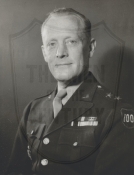
Major General Withers A. Burress, Commanding General of the 100th Division, Fort Jackson, South Carolina, 1943.

2nd Lt. W. J. Benardo operating keying equipment in master control room at Communications School. 100th Infantry Division. Fort Jackson, South Carolina. February 2, 1943.

Interior classroom at Communications School. 100th Infantry Division. Fort Jackson, South Carolina. February 10, 1943.

L to R: Sgt. R. Compton and Lt. W. E. Vazzana demonstrating hand to hand combat methods of disarming man with fixed bayonet. Position #2. A squat position, left hand is placed on the stock of gun and the right hand is free. Second Army Ranger School. Camp Forrest, Tennessee. February 11, 1943.

L to R: Sgt. R. Compton and Lt. W. E. Vazzana demonstrating hand to hand combat methods of disarming man with fixed bayonet. Position #3. Both hands placed on opponents left hand and on stock of rifle and the right foot placed on opponents right foot, then give the rifle a twist outward. Second Army Ranger School. Camp Forrest, Tennessee. February 11, 1943.

L to R: Sgt. R. Compton and Lt. W. E. Vazzana demonstrating hand to hand combat methods of disarming man with fixed bayonet. Position #4. Twist opponents left hand by downward thrust. This will make opponent release his hold on the rifle. Second Army Ranger School. Camp Forrest, Tennessee. February 11, 1943.

L to R: Sgt. R. Compton and Lt. W. E. Vazzana demonstrating hand to hand combat methods of disarming man with fixed bayonet. Position #5. Opponent is thrown to the ground and is being hit in the face with the butt of the gun. Second Army Ranger School. Camp Forrest, Tennessee. February 11, 1943.

L to R: Sgt. R. Compton and Lt. W. E. Vazzana demonstrating hand to hand combat methods of disarming man with fixed bayonet. Position #6. Opponent has been thrown to the ground and is being stabbed in the neck. Second Army Ranger School. Camp Forrest, Tennessee. February 11, 1943.

L to R: Sgt. R. Compton and Lt. W. E. Vazzana demonstrating hand to hand combat methods of disarming opponent with a trench knife. Position #1. Feet 18 inches apart to secure balance, right elbow placed on opponent’s right should, hand below knife. Second Army Ranger School. Camp Forrest, Tennessee. February 11, 1943.
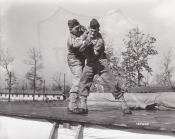
L to R: Sgt. R. Compton and Lt. W. E. Vazzana demonstrating hand to hand combat methods of disarming opponent with a trench knife. Position #2. Opponent’s grip on knife is broken by applying arm lock. Throw opponent to floor as he drops knife. Second Army Ranger School. Camp Forrest, Tennessee. February 11, 1943.
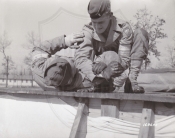
L to R: Sgt. R. Compton and Lt. W. E. Vazzana demonstrating hand to hand combat methods of disarming opponent with a trench knife. Position #3. After opponent is thrown to ground a right arm lock is applied. Hold lock with your left hand and free the right hand and pick up the knife. Second Army Ranger School. Camp Forrest, Tennessee. February 11, 1943.
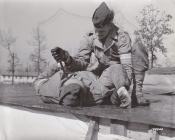
L to R: Sgt. R. Compton and Lt. W. E. Vazzana demonstrating hand to hand combat methods of disarming opponent with a trench knife. Position #4. Opponent is now ready for the kill. Second Army Ranger School. Camp Forrest, Tennessee. February 11, 1943.

L to R: Lt. W. E. Vazzana and Sgt. J. R. Compton demonstrating methods of dirty fighting tactics. Second Army Ranger School. Camp Forrest, Tennessee. February 11, 1943.
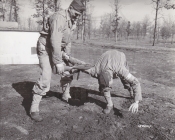
L to R: Sgt. R. Compton and Lt. W. E. Vazzana demonstrating how to tie down an opponent with the rifle and the fixed bayonet. Position rifle placed on extended right arm and body of opponent. Apply pressure to right arm forcing opponent to ground. Second Army Ranger School. Camp Forrest, Tennessee. February 11, 1943.

L to R: Sgt. R. Compton and Lt. W. E. Vazzana demonstrating method of timing down an opponent with rifle and fixed bayonet. Position #2. Opponent falls to ground helpless and may be tied down indefinitely by applying pressure to right arm. Second Army Ranger School. Camp Forrest, Tennessee. February 11, 1943.
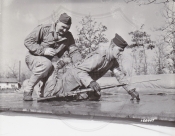
L to R: Sgt. R. Compton and Lt. W. E. Vazzana demonstrating hand to hand combat method of attacking man from rear. Position #1. Knock your opponent to the ground from the rear and place his right leg forward, apply pressure, and force him to the ground. Second Army Ranger School. Camp Forrest, Tennessee. February 11, 1943.

L to R: Sgt. R. Compton and Lt. W. E. Vazzana demonstrating hand to hand method of disarming opponent armed with fixed bayonet from the rear. Position #2. Your opponent is down and helpless and dirty fighting tactics are now in order. Second Army Ranger School. Camp Forrest, Tennessee. February 11, 1943.
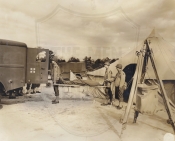
XIIth Corps Command Inspection of the 100th Infantry Division. Members of the 325th Medical Battalion go through their paces for the inspector.
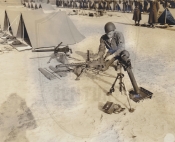
XIIth Corps Command Inspection of the 100th Infantry Division. A sergeant gives some last-minute touches to his heavy weapons.
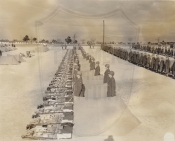
XIIth Corps Command Inspection of the 100th Infantry Division. 100th Infantry Division unit lined up for an inspection of field equipment.

From L to R (Front Row only) Maj. Gen. W. A. Warren, Maj. Gen. W. H. Simpson, and S/Sgt. B. J. Wilson in supply room at command inspection at Fort Jackson, South Carolina. 100th Signal Company Supply Room. February 11, 1943.
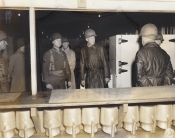
XIIth Corps Command Inspection of the 100th Infantry Division. General Simpson looking over one of the enlisted men’s mess halls.
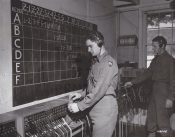
Pvt. J.A. McGee and Pvt. H.P. Vonel operating monitoring switchboard at Communication School. 100th Infantry Division. Fort Jackson, South Carolina. February 11, 1943.
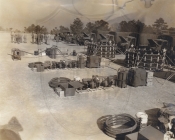
XIIth Corps Command Inspection of the 100th Infantry Division. More equipment on display while awaiting inspecting officer.
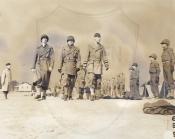
XIIth Corps Command Inspection of the 100th Infantry Division. Major General Simpson of XIIth Corps inspecting troops and equipment.

"Division review for XIIth Corps Commander and State Governor, March 13, 1943.
In the reviewing stand (L-R): Gen. Miller, Gov. Johnson, Gen. Simpson, Gen. Eckfelt (26th Infantry Division), Gen. Burress, Gen. Logan (26th Infantry Division), and Gen. Beebe (Ft. Jackson)."
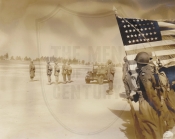
Division review for XIIth Corps Commander and State Governor, March 13, 1943. Governor Johnson and General Simpson reviewing the Division in a Jeep before the troops passed in review.
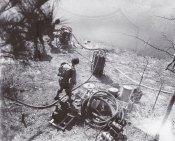
General view of water purification system on edge of lake. Water purification pump: center, water purifier, foreground, booster pumps and other equipment used in conjunction with 3000 gallon water purification unit. Headquarters Company, 325th Engineer Battalion, 100th Infantry Division. Fort Jackson, South Carolina. March 24, 1943.
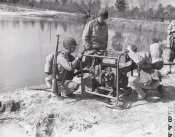
L to R: Pvt. David Weiss, New York City, New York; Pvt. Clyde Simmons, Harrisburg, Pennsylvania; and Sgt. Thomas Mally, New York City, New York, making adjustments on water purification pump. Headquarters Company, 325th Engineer Battalion, 100th Infantry Division. Fort Jackson, South Carolina. March 24, 1943.
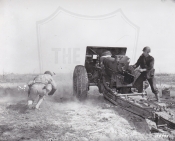
155mm Howitzer in recoil after firing during problem at Fort Jackson, South Carolina. Battery ‘B’, 373rd Field Artillery Battalion, 100th Infantry Division. March 24, 1945.
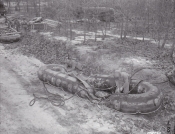
L to R: Pvt. Philip Sieva, Pawtucket, Rhode Island, and Abe W. Haffer, Brooklyn, New York, inflating pneumatic floats to be used in construction of 6-ton pneumatic bridge. Company ‘B’, 325th Engineer Battalion, 100th Infantry Division. Fort Jackson, South Carolina. March 26, 1943.
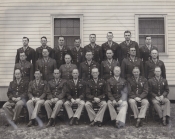
"General Burress, General Miller, and General Buechler with the General and Special Staffs at Officers Club, Fort Jackson. April 1943.
First Row (L-R): Capt. Miller, acting G-3; Lt. Col. Stegmaier, G-4; Col. McClure, chief of staff; Gen. Miller, assistant division commander; Gen. Burress, commanding general; Gen. Buechler, artillery commander; Lt. Col. Forbush, G-1; Maj. Reinecke, G-2.
Second Row (L-R): Lt. Col. Kemble, ordnance; Lt. Col. Olin, signal; Lt. Col. Gingrich, inspector; Lt. Col. Nelson, adjutant; Lt. Col. Mollohan, surgeon; Lt. Col. Dougherty, engineer; Lt. Col. Carter, chaplain.
Third Row (L-R): Maj. Craig, special service; Capt. Lewis, reconnaissance troop; Maj. Walker, quartermaster; Maj. Betz, chemical warfare; Maj. Long, finance; Maj. Byrd, headquarters commandant; Capt. Foster, judge advocate; Lt. Rothe, acting provost marshall."
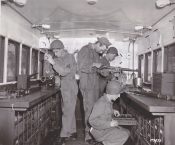
Sgt. Frank D. Thomas, Northfield, Ohio, Pvt. Dan G. Spear, New York City, and Pvt. John P. Masce, Sagano, Michigan, Pfc. Joe E. Donahue, Cincinnati, Ohio working in the small arms portable truck. 800th Ordnance Company. Fort Jackson, South Carolina. April 20, 1943.
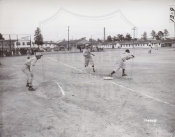
John Libbey, catcher, Brooklyn, New York, beaten out on a bounder to Ochal, shortstop for Shawfield in the the second inning in a game between the Division and Shawfield. 100th Infantry Division. Fort Jackson, South Carolina. April 21, 1943.

Members of the field artillery using live ammunition admits live dynamite charges, run through the “German Village” o the Ranger Course for training. 374th Field Artillery Battalion, 100th Infantry Division. Fort Jackson, South Carolina. April 22, 1943.

Members of the field artillery using live ammunition admits live dynamite charges, run through the “German Village” o the Ranger Course for training. 374th Field Artillery Battalion, 100th Infantry Division. Fort Jackson, South Carolina. April 22, 1943.
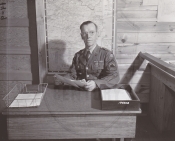
M/Sgt. James Cary, a senior noncommissioned officer, has received commendations from 5 different generals during the course of 28 years of soldiering all over the world. Service Company, 398th Infantry Regiment, 100th Infantry Division. Fort Jackson, South Carolina. April 24, 1943.
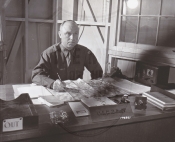
Col. R. E. Duff, Commanding Officer, 398th Infantry Regiment, 100th Infantry Division. Forth Jackson, South Carolina. April 24, 1943.
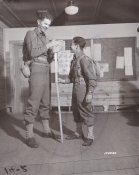
A bit of “G.I.” is pictured here as Cpl. Anthony P. Guinta, a five-footer, is to be measured by six foot, five inch Pvt. James J. Fox. Guinta resides in Brooklyn, New York, and Fox is a resident of Congers, New York. Company ‘G’, 2nd Battalion, 398th Infantry Regiment. Fort Jackson, South Carolina. 1943.
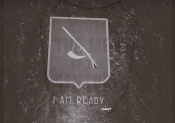
Insignia inlayed in the linoleum in the foyer of Chapel #6, Fort Jackson, South Carolina. 399th Infantry Regiment, 100th Infantry Division. April 24, 1943.
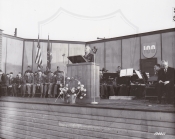
Lt. Col. Edwin Carter, Division Chaplain, delivering a prayer at the Easter Morning Sunrise Service in the open air stage at Fort Jackson, South Carolina. 100th Infantry Division. April 25, 1943.
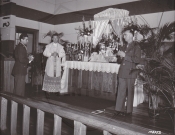
Father Ralph F. Neagls, Chaplain attached to Field Artillery units, celebrates Easter Mass at Chapel #3, Fort Jackson, South Carolina. 100th Infantry Division. April 25, 1943.
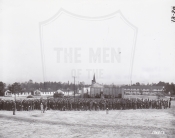
General View of the congregation which attended the Easter Sunrise Service at Fort Jackson, South Carolina. 100th Infantry Division. April 25, 1943.
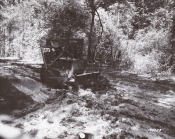
Bull-dozer scraping heavy mud from the road to clear it temporarily for heavy truck traffic handling parts of the heavy pontoon bridge being built across the Naterles River. 325th Engineer Battalion. Fort Jackson, South Carolina. April 26, 1943.

Lt. Col. John T. King, Worchester, Massachusetts, and Col. B. A. Page, Eagle, North Carolina, discussing the results of an inspection. Lt. Col. King, Commanding Officer of the 3rd Battalion of the 399th Infantry Regiment. Col. Page, General Staff Corps, 12th Army Corps. Fort Jackson, South Carolina. April 26, 1943.
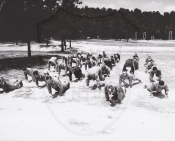
Doing the “Burpee” exercise. This exercise is part of the Second Army physical fitness program. Fort Jackson, South Carolina. Company ‘M’, 3rd Battalion, 399th Infantry Regiment, 100th Infantry Division. April 26, 1943.
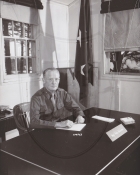
Major General Withers A. Burress is Commanding General at Fort Jackson, South Carolina. Maj. Gen. Burress is from Richmond, Virginia. 100th Infantry Division. April 26, 1943.
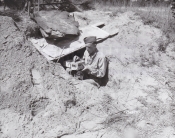
Sgt. Merritt Briggs, Jamestown, New York, with Chemical Section, handling the detonator box that sets off chemical bombs. During a Chemical Warfare demonstration. 100th Infantry Division Chemical Section. Fort Jackson, South Carolina. April 27, 1943
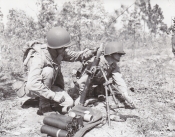
Firing the 60mm M2 Mortar during training maneuvers. Behind the gun, left to right, are Pfc. Nick S. Derenzo, New York City, and Pfc. Walter Roberts, Weymouth, Massachusetts. 397th Infantry Regiment, 100th Infantry Division. Fort Jackson, South Carolina. April 28, 1943.
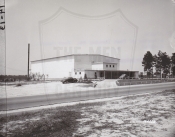
Exterior of Post Theater #4. Fort Jackson, South Carolina. 100th Infantry Division Area. April 28, 1943.
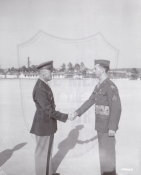
Maj. Gen. A. Burress congratulates Sgt. Thomas J. Hohman after presenting him with the Soldier’s Medal for heroism during a railroad wreck near Fredericktown, Maryland on September 24, 1942. 100th infantry Division. Fort Jackson, South Carolina. April 29, 1943.
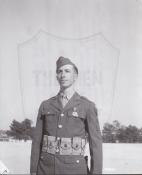
Sgt. Thomas J. Hohman wearing the Soldier’s Medal for heroism presented to him for his heroic assistance during a railroad wreck on the Baltimore and Ohio line near Fredericktown, Maryland, on September 24, 1942. April 29, 1943. Fort Jackson, South Carolina. Photographed by Pvt. Weaver of the 163rd Signal Photographic Company.
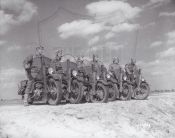
Pfc.’s Nelligan, Mueller, Priest, Paskowitz, Kowalski, and Dearborn line up on their “bikes” in preparation to leave on reconnaissance mission. 100th Mechanized Cavalry Reconnaissance Troop. Fort Jackson, South Carolina. 1943.
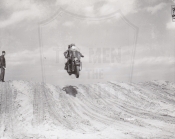
Pfc. Harold Dearborn, Springfield, Massachusetts, “takes it in high”. Pfc. Dearborn is twenty years old and had never ridden before coming into the Army. His training was received from Lt. Clifford Carrier, master motorcyclist. 100th Mechanized Cavalry Reconnaissance Troop. Fort Jackson, South Carolina. 1943.

Pfc. Edward Mueller of Newark, New Jersey, starting to spin preparation to use “bike as a barricade”. 100th Mechanized Cavalry Reconnaissance Troop. Fort Jackson, South Carolina. 1943.
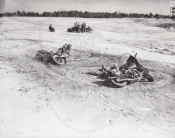
Pfc. Edward Mueller of Newark, New Jersey, is demonstrating method of using morticycle as barricade in combat. 100th Mechanized Cavalry Reconnaissance Troop. Fort Jackson, South Carolina. 1943.
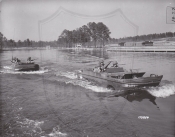
Members of a scouting party travel up stream on one of their missions in amphibious trucks. Intelligence and Reconnaissance Platoon, Headquarters Company, 397th Infantry Regiment, 100th Infantry Division. Fort Jackson, South Carolina. 1943.
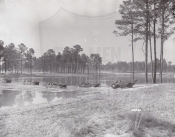
Landing amphibious trucks. Intelligence and Reconnaissance Platoon, Headquarters Company, 397th Infantry Regiment, 100th Infantry Division. Fort Jackson, South Carolina. 1943.
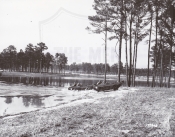
3,200 pound amphibious trucks emerge after crossing a lake. Intelligence and Reconnaissance Platoon, Headquarters Company, 397th Infantry Regiment, 100th Infantry Division. Fort Jackson, South Carolina. 1943.
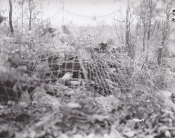
.30 Cal. Water Cooled Machine Gun in one of its emplacements. Company ‘H’, 2nd Battalion, 398th Infantry Regiment, 100th Infantry Division. Fort Jackson, South Carolina. 1943.
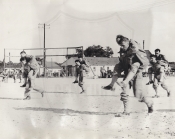
Soldiers of Century Division carrying one-another, piggy-back fashion, for 75 yards in division’s physical fitness tests conducted by XIIth Corps at conclusion of second phase of training.
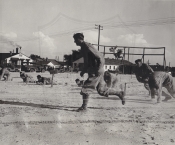
100th Infantry Division soldiers shown at start of one fete in physical fitness tests conducted by XIIth Corps at end of second training phase in program.
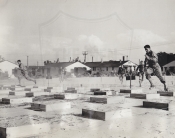
Men of 100th Infantry Division going through box-stepping in physical fitness tests conducted by XIIth Corps at conclusion of second phase of training.
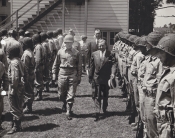
Representatives of manufacturers associations visit 100th Infantry Division and inspect soldiers. Idea of visit was to acquaint manufactures with the uses to which their products are being put by soldiers.

Regimental Staff.
Left to Right: Capt. E. L. Lecrone, Chaplain; Maj. R. H. Whitus, S-4; Lt. Col., L. Zimmerman, Ex. O.; Col. R. E. Duff, C.O.; Maj. H. C. Weisel, Jr., S-3; Capt. E. J. Stone, S-1; 1st Lt. E. D. Hollister, Jr., Per. O.; 1st Lt. S. J. Light, S-2
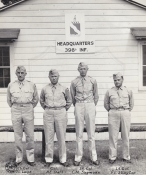
"398th Infantry Regiment Battalion Commanders:
Lt. Col. T. L. Leigh
Col. R. E. Duff
Lt. Col. C. M. Sagmoen
Lt. Col. F. E. Stayton"
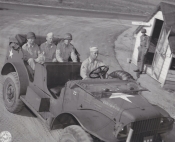
Gen. McNair visits 100th Infantry Division. Lt. Gen. Lesley J. McNair, commander of the Army Ground Forces, is shown riding to the 100th Infantry Division bivouac in Fort Jackson during a July field exercise. Stopping in the 100th Infantry Division area for a brief observation of training, he saw units of the Century in various phases of their work while they were encamped on the reservation. Accompanying Gen. McNair, who is seated in the rear, left, are: Maj. Gen. Withers A. Burress, division commander; and Maj. Gen. William G. Simpson, commander of XIIth Corps, of which the 100th Infantry Division was then a unit.
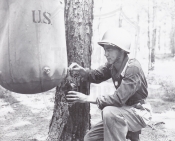
Pvt. Chuck Wong, Lynn, Massachussetts, shown drawing water from lister bag during field problem at Fort Jackson, South Carolina. Headquarters Company, 100th Infantry Division. July 25, 1943.
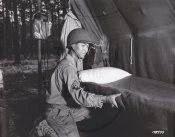
T/5 Walter Ngee Yee, Canton, China, and New York, New York, show straightening Maj. Gen. Burress’ bunk. Yee is orderly for Maj. Gen. Burress. Headquarters Company, 100th Infantry Division. Fort Jackson, South Carolina. July 26, 1943.
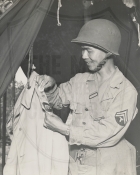
Japanese Americans in Army Train to Avenge Pearl Harbor; 100th Infantry Battalion Officers and most of the enlisted men are of Japanese ancestry. American citizens born in the Hawaiian Islands of unquestioned loyalty and patriotism. Formerly part of the Hawaiian National Guard, Cpl. Ngee Yee is an orderly for General Burress, 100th Infantry Division. 1943.
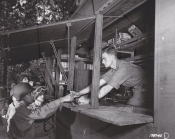
Paying for drink, Cpl. Anthony Rizzo, Lyndhurst, New Jersey, handing bottle to Lt. Wm. E. Vazzana, Monongahela, Pennsylvania, at field PX. Company ‘K’, 3rd Battalion, 397th Infantry Regiment and Special Service, 100th Infantry Division. Fort Jackson, South Carolina. July 26, 1943.
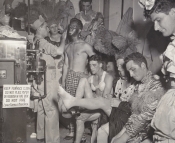
Show Time. Centurymen are seen here making the transformation from soldiers to actors. The occasion was the showing of “The Show of the Century,” a musical review staged by the division’s Special Service Office on August 19, 1943, at Fort Jackson. Shown applying greasepaint to the blackface character is S/Sgt. Peter Bayes, who was principal in a previous division theatrical, “The Eve of St. Mark.” He is the son of the celebrated Nora Bayes, singer of another year.
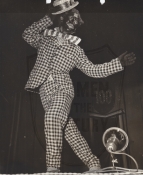
In blackface and flashy civilian uniform — for an evening — this 100th Infantry Division man swings into his dance routine in the Division’s “Show of the Century,” presented by the Special Service Office August 19, 1943, at Fort Jackson. He is Pfc. Howard Neville, of Company ‘C’, 325th Engineer Battalion, who was one of the show’s large musical review cast.
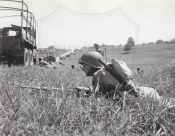
Sgt. Albert F. Fraraccio from Jersey City, New Jersey, of Company ‘B’, 1st Battalion, 398th Infantry Regiment, taking a battle position on contact with the enemy during a motorized march north of Winnsboro, South Carolina. This was part of the “D” series field problems for the XIIth Corps. September 30, 1943. Photographed by Pfc. Gilbert.

P-39 attacking motor convoy of the 925th Field Artillery Battalion north of Columbia, South Carolina. The 925th Field Artillery Battalion is part of the 100th Infantry Division. Taken for the 12th Corps. October 5, 1943. Photographed by Lt. Bell.
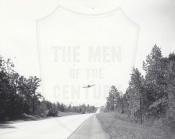
P-39 attacking motor convoy of the 925th Field Artillery Battalion, 100th Infantry Division, north of Columbia, South Carolina, during air attack problem.Taken for 12th Corps. October 5, 1943. Photographed by Lt. Bell.
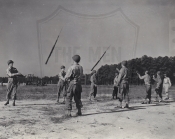
397th Infantry Regiment 100th Infantry Division going through Bayonet Practice at Fort Jackson, South Carolina. This exercise overcomes ones fear of the bayonet. The men are: Sgt. DeLeeuw, Cpl. McLaughlin, Sgt. McGinly, Cpl. Hahle, Sgt. Matcalfe, Sgt. Heck, Sgt. McMenamin, Sgt. Ramsey, and Lt. Roberta. Taken for Lt. Whited, 100th Infantry Division. Photographed by Sgt. Rasmussen. October 15, 1943.
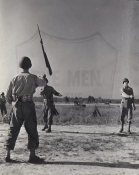
397th Infantry Regiment, 100th Infantry Division going through bayonet practice at Fort Jackson, South Carolina. This exercise overcomes ones fear of the bayonet. The men are: Sgt. DeLeeuw and Cpl. McLaughlin. Taken for Lt. Whited, 100th Infantry Division. Photographed by Sgt. Ramussen. October 15, 1943.
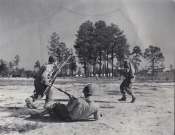
Sgt. Ramsy on left demonstrates how one can overcome two in a bayonet duel. Sgt. Heck and Sgt. Metcalfe are the other soldiers. This was during a phase of their bayonet training at the practice field of 100th Infantry Division at Fort Jackson, South Carolina. Taken for the 100th Infantry Division Lt. Roberts. Photographed by Sgt. Rasmussen. October 15, 1943.
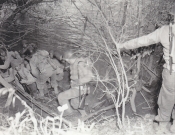
Second Battalion of 399th Infantry Regiment preparing to cross Wateree River at a point 5 miles west of Camden, South Carolina, in assault boats. Taken for the 100th Infantry Division. October 28, 1943. Photographed by Pfc. Gilbert.
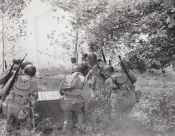
Second Battalion of 399th Infantry Regiment preparing to cross Wateree River at a point 5 miles west of Camden, South Carolina, in assault boats. Taken for the 100th Infantry Division. October 28, 1943. Photographed by Pfc. Gilbert.
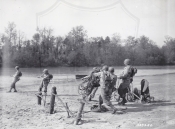
325th Engineer Battalion stretching rope for foot bridge across the Wateree River 5 miles west of Camden, South Carolina. 100th Infantry Division. October 30, 1943
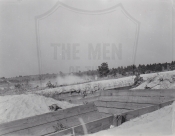
Company ‘E’, 399th Infantry Regiment, throwing live fragmentation hand grenades at the dummy targets at Fort Jackson, South Carolina. Photographed by Pfc. Gilbert. November 1, 1943.
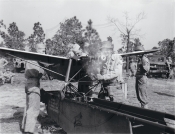
Crew members get ready to launch a radio controlled airplane target OQ-2A, from catapult, at the anti-aircraft range, Fort Jackson, South Carolina. November 1, 1943.
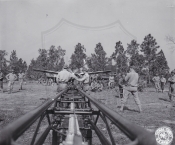
Getting ready to launch radio controlled airplane target OQ-2A from the catapult at the AA range at Fort Jackson, South Carolina. Crew Members are Pfc. G. Sickles, Mechanicsville, New York; Cpl. W. Nezdodicksky, Pleasantville, New York; and T/5 Gordon Spaulding, Ludlow, Vermont. All of of them are in the 373rd Field Artillery Battalion. November 1, 1943. Photographed by Pfc. Gilbert, 166th Signal Photographic Company.
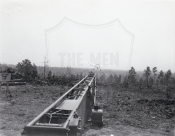
Radio controlled airplane target OQ-2A taking off from catapult at the AA range at Fort Jackson, South Carolina. November 1, 1943. Taken for the 100th Infantry Division by Pfc. Gilbert, 166th Signal Photographic Company.
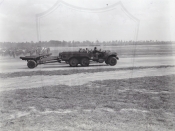
6x6 weapons carriers drawing 105mm howitzers passing the reviewing stand in 100th Infantry Division’s last review at Fort Jackson, South Carolina. November 5, 1943.
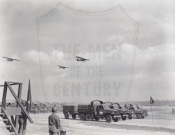
Vehicles and planes pass in review for the 100th Infantry Division’s last review at Fort Jackson, South Carolina. November 5, 1943.
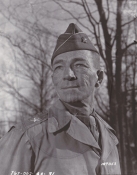
Brig. Gen. Maurice L. Miller, from Oronoco, Minnesota. Assistant Division Commander of the 100th Infantry Division. Second Army Maneuvers. Tennessee Maneuvers. January 1, 1944.
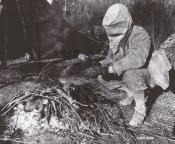
Pfc. Stanley Papkin, warming hands by fire, wearing head net. Pfc. Papkin is from 6913 18th Ave. Brooklyn, New York. 2nd Army Tennessee Maneuvers. Tennessee Maneuvers. Photographed by 100th Signal Company. January 6, 1944.
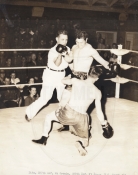
Litz, 397th Infantry Regiment, vs. Cronin, 398th Infantry Regiment. Ft. Bragg, North Carolina. March 1944.
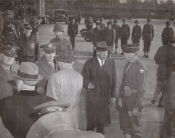
Maj. Gen. Withers A. Burress, 100th Infantry Division Commander, greets Undersecretary of War Robert P. Patterson who, together with a party of leading American newspaper publishers, inspected the Century Division on March 3, 1944.

Undersecretary of War Robert P. Patterson prepares to inspect the troops of the 100th Infantry Division during his visit here on March 3, 1944. Sitting with Mr. Patterson in the jeep is Maj. Gen. Withers A. Burress, Commanding General, 100th Infantry Division
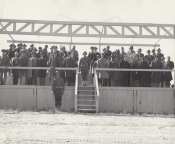
Undersecretary of War Robert P. Patterson and an accompanying party of leading American publishers look from the reviewing stand as the 100th Infantry Division staged a full scale review on March 3, 1944. Maj. Gen. Withers A. Burress, Commanding General, 100th Infantry Division, stands at the head of the steps. Mr. Patterson is on Gen. Burress’ right and Maj. Gen. Alvan C. Gillim, Jr., XIIIth Corps Commander, is on his left.
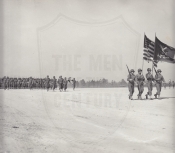
Units of the 100th Infantry Division’s 397th Infantry Regiment pass in review before Undersecretary of War Robert P. Patterson during his visit to the Century Division on March 3, 1944. A full division review was staged for Mr. Patterson and the party of leading American newspaper publishers which accompanied him.

Undersecretary of War Robert P. Patterson tastes a sample of G.I. chow during his inspection of the 100th Infantry Division March 3, 1944. Standing on Mr. Patterson’s right is Maj. Gen. Withers A. Burress, 100th Infantry Division Commander. The Undersecretary was accompanied by a party of leading American newspaper publishers.
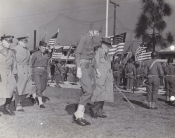
Secretary of War Stimson visits Fort Bragg, July 1944. General Burress behind Stimson, Lt. Col. Sagmoen at his right.

Orders awarding T/Sgt. Walter L. Bull, 100th Infantry Division’s 399th Infantry Regiment, the first Expert Infantryman’s Badge in Army history, are read over the public address system to the entire 100th Infantry Division massed in the background. The Division color guard is in the foreground and at the extreme left are Lt. Gen. Lesley J. McNair, Commanding General, Army Ground Forces (with Blouse) and Maj. Gen. Withers A. Burress, Commanding General, 100th Infantry Division.
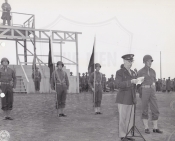
Orders awarding T/Sgt. Walter L. Bull, 100th Infantry Division’s 399th Infantry Regiment, the first Expert Infantryman’s Badge in Army history, are read over the public address system to the entire 100th Infantry Division. At the left foreground are Lt. Gen. Lesley J. McNair, Commanding General, Army Ground Forces (with Blouse) and Maj. Gen. Withers A. Burress, Commanding General, 100th Infantry Division.
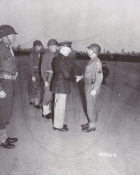
"First soldier to win Expert Infantrymen Badge.
This photo is of the ceremonies at Ft. Bragg, North Carolina, during which Lt. Gen. Lesley J. McNair, Commanding General of the Army Ground Forces, made the first presentation the U.S. Army’s new award, the Expert Infantryman Badge. The recipient was Sgt. Walter L. Bull, Company ‘A’, 1st Battalion, 399th Infantry Regiment, 100th Infantry Division. The badge gives recognition to Infantry soldiers who have proved their ability in tests designed to measure their skill, agility, and endurance. It is in the form of a miniature silver musket mounted on an Infantry blue background with a silver boarder. "
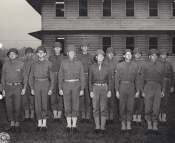
These ten enlisted men achieved the highest scores in the first tests conducted within the 100th Infantry Division to qualify men for the new Expert Infantryman’s Badge. T/Sgt. Walter L. Bull (extreme left front row), of Dundalk, Maryland, and the 100th Infantry Division’s 399th Infantry Regiment, received the first Badge in Army history on March 29, 1944. Standing with he expert Infantrymen are Maj. Gen. Withers A. Burress (third from left in front row), Division Commander, and Brig. Gen. Maurice L. Miller (on Gen. Burress’ left) Assistant Division Commander.

Left to Right: T/Sgt. Robert Marlatt, T/Sgt. Aaron G. Rogers, T/Sgt. John J. Hutchinson, 1st Sgt. Herbert L. Turner, T/Sgt. John L. Brady, Maj. Gen. Withers A. Burress, Unknown, T/Sgt. Alphonse W. Siemasko, T/Sgt. Jack P. Albaugh, T/Sgt. Joseph Shovlowsky, T/Sgt. Alvie J. Hogan, T/Sgt. Walter L. Bull
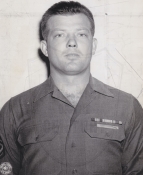
This is T/Sgt. Walter L. Bull, of Dundalk, Maryland, and the 100th Infantry Division’s 399th Infantry Regiment, who, on March 29, 1944, became the first soldiers in the United States Army to receive the new Expert Infantryman’s Badge. Lt. Lesley J. McNair, Commanding General, Army group Forces, presented the badge to this 26-year old former steel worker at a colorful formal review.
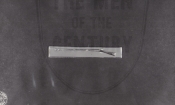
This is the new Expert Infantryman’s Badge which was established by the War Department this year to recognize the importance of proficient Infantry. A 100th Infantry Division soldier, T/Sgt. Walter L. Bull of the 399th Infantry Regiment, received the first Expert Infantryman’s Badge ever awarded in the United States Army on March 29, 1944. Lt. Gen. Lesley J. McNair, Commanding General of the Army Ground Forces, made the award at a colorful formal review.
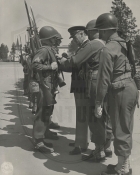
Major General Withers A. Burress presenting the Expert Infantryman's award to the first 23 members of the 398th Infantry to win this honor.

As part of demonstrations staged for visiting American newspaperman on April 15, 1944, the 325th Medical Battalion, of the 100th Infantry Division demonstrates the tactics of the medical units in combat. Shown here is the traction spine for a leg fracture.

Shown here is the 1944 100th Infantry Division baseball team coached by Jefferson Hudson (front row center), former 1st base star for Washington and Lee University. At Lt. Hudson’s left is Rudy Mazur, the club’s leading hitter in batting averages, triples, and home runs.
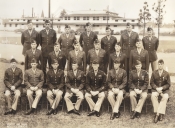
"The Division Staff in May 1944.
First Row (L-R): Capt. N. D. Lewis, acting G-2; Lt. Col. R. M. Stegmaier, G-4; Col. M. McClure, chief of staff; Brig. Gen. M. L. Miller, assistant divisional commander; Maj. Gen. W. A. Burress,, division commander; Brig Gen. J. B. Murphy, division artillery commander; Lt. Col. C. H. Forbush, G-2; and Lt. Col. K. E. Eckland, G-3.
Second Row (L-R): Lt. Col. F. Kemble, ordnance officer; Lt. Col. L. Morse, inspector general; Lt. Col. C. S. Mollahan, surgeon; Lt. Col. (Chaplain) C. P. Malumphy, chaplain; Lt. Col B. De La Mater, adjutant general; and Lt. Col. J. Long, finance officer.
Third Row (L-R): Maj. H. T. Paris, special services officer; Maj. L. Mussler, signal officer; Maj. J. A. Allgoir, engineer; Lt. Col. J. Byrd, headquarters commadant; Maj. J. Cherry, provost marshall; Maj. J. Foster, judge advocate; and Capt. J. Mitchell, reconnaissance troop commander."
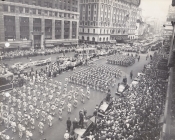
The 100th Infantry Division Band and “New York Battalion” opening the Motion Picture War Activities Committee’s Fifth War Loan Drive on Times Square in June 1944.

The 100th Infantry Division Band and “New York Battalion” parading on Fifth Avenue in New York City for the official opening of Fifth War Loan Drive.
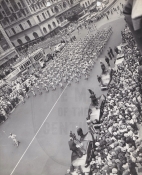
The 100th Infantry Division’s Band and “New York Battalion” opening the Motion Picture War Activities Committee’s Fifth War Loan Drive on Times Square in June 1944.
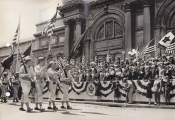
The 100th Infantry Division colors pass the reviewing stand on the steps of the Metropolitan Museum of Art in New York City for the opening fo the Fifth War Loan Drive.

The 100th Infantry Division’s “New York Battalion” marching up lower Broadway in New York City on June 15, 1944, in celebration of the first Infantry Day.
The 100th Infantry Division Honor Troops at the opening of the 5th War Bond Drive ceremonies. Times Square, New York City. June, 1944.
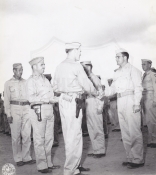
Col. E. E. Keatly presenting Expert Infantryman’s Badge to Pfc. E. Paviano, Anti-Tank Company, 398th Infantry Regiment. Capt. Elgie J. Stone in rear. July 1944.
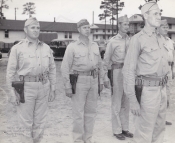
398th Infantry Regiment Regimental Staff, July 1944:
Col. Keatly: Commanding Officer
Capt. Stone: S-1
Maj. Whitus: S-3
Maj. Gilman: S-2
Capt. Parks: S-4
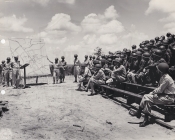
Maj. Gen. Withers A. Burress orienting the party of North Carolina industrialists on the play of the problem before a demonstration showing an Infantry Battalion in the defense.

Gen. Burress & Col. Reineke with Fayetteville Industrial Leaders. Fort Bragg, North Carolina. July 1944.
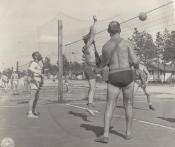
"War On the Volleyball Court
Fort Bragg, North Carolina: This is one form of training for war that can be adapted to playing volleyball, or any kind of physical workout you want to name. Show here are staff officers of the 100th Infantry Division wearing gas masks during action in a fast-moving volleyball game. Under present Army training regulations, all officers and men of the Century Division are undergoing this training. 30 minutes a day, once a week. Set up to accustom all personnel to wearing of the mask during physical exertion, the training requirement is carried out by men and officers in calisthenics, athletics, as shown above, and bayonet drill. Public Relations Office, 100th Infantry Division. Fort Bragg, North Carolina."
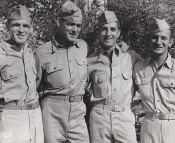
Rescuers of five crashed paratroopers recipients of Soldiers Medal. Left to Right:
Sgt. Dennis R. Walker
Pfc. Arthur R. Dobler
S/Sgt. Wm G. Murphy
S/Sgt. Wilbur Giles
